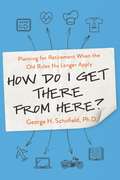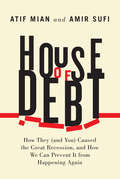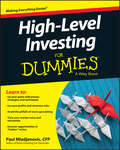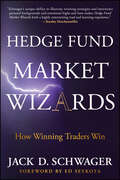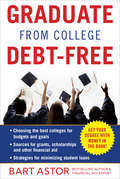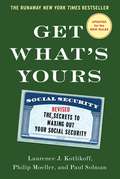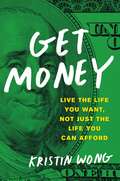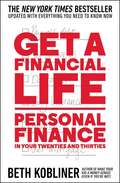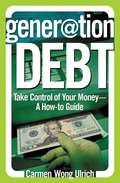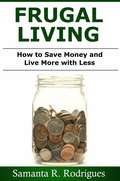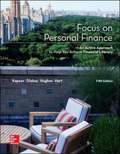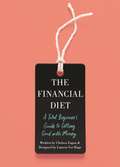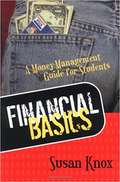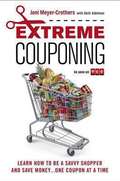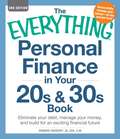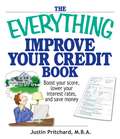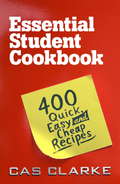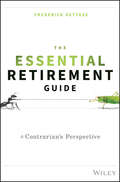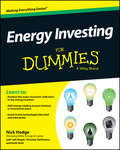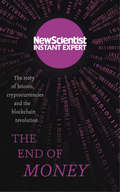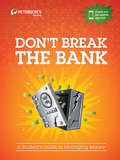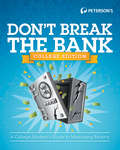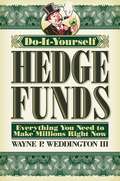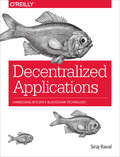Special Collections
Focus on Finance
- Table View
- List View
How Do I Get There from Here?
by George SchofieldNo matter how far or close you think you are to retirement, this book is your one-stop guide to help you plot your direction for the coming decades.Not long ago everyone knew what the word retirement meant--retire at age 65 after 40 years at the same job and coast through your golden years courtesy of a comfortable nest egg. But now, age expectancy is higher, savings are slimmer, and people change jobs more frequently. Clinging to this outdated concept of retirement only gets you a room in your kids&’ house. Your retirement is going to require an incremental approach to planning--and you must begin now. This requires conscious engagement, diverse interests, and the ability to adapt.In How Do I Get There from Here?, readers will first be directed how to review all their assets--both tangible and intangible--so they can get an honest assessment of where they are right now. Then a journey through self-reflective questions and exercises will:walk you through imagining your future,identifying skills you&’ll need,and learning how to prepare for inevitable twists and turns along the way.Stop clinging to an ancient and stereotypical idea of retirement. Decades of nonstop leisure is not only unreachable for most, it&’s not even truly desirable. Begin now charting the path for a unique, dynamic future you can look forward to!
House of Debt
by Atif Mian and Amir SufiThe Great American Recession resulted in the loss of eight million jobs between 2007 and 2009. More than four million homes were lost to foreclosures. Is it a coincidence that the United States witnessed a dramatic rise in household debt in the years before the recession―that the total amount of debt for American households doubled between 2000 and 2007 to $14 trillion? Definitely not. Armed with clear and powerful evidence, Atif Mian and Amir Sufi reveal in House of Debt how the Great Recession and Great Depression, as well as the current economic malaise in Europe, were caused by a large run-up in household debt followed by a significantly large drop in household spending.
Though the banking crisis captured the public’s attention, Mian and Sufi argue strongly with actual data that current policy is too heavily biased toward protecting banks and creditors. Increasing the flow of credit, they show, is disastrously counterproductive when the fundamental problem is too much debt. As their research shows, excessive household debt leads to foreclosures, causing individuals to spend less and save more. Less spending means less demand for goods, followed by declines in production and huge job losses. How do we end such a cycle? With a direct attack on debt, say Mian and Sufi. More aggressive debt forgiveness after the crash helps, but as they illustrate, we can be rid of painful bubble-and-bust episodes only if the financial system moves away from its reliance on inflexible debt contracts. As an example, they propose new mortgage contracts that are built on the principle of risk-sharing, a concept that would have prevented the housing bubble from emerging in the first place.
Thoroughly grounded in compelling economic evidence, House of Debt offers convincing answers to some of the most important questions facing the modern economy today: Why do severe recessions happen? Could we have prevented the Great Recession and its consequences? And what actions are needed to prevent such crises going forward?
High Level Investing For Dummies
by Paul MladjenovicDo you have an investment portfolio set up, but want to take your knowledge of investing a step further? High-Level Investing For Dummies is the resource you need to achieve a more advanced understanding of investment strategies—and to maximize your portfolio's profits. Build upon your current knowledge of investment, particularly with regard to the stock market, in order to reach a higher level of understanding and ability when manipulating your assets on the market. This approachable resource pinpoints key pitfalls to avoid and explains how to time your investments in a way that maximizes your profits.
Investing can be intimidating—but it can also be fun! By building upon your basic understanding of investment strategies you can take your portfolio to the next level, both in terms of the diversity of your investments and the profits that they bring in. Who doesn't want that?
High-Level Investing For Dummies is the perfect follow-up to Stock Investing For Dummies, and is a wonderful resource that guides you through the process of beefing up your portfolio and bringing home a higher level of profits!
Hedge Fund Market Wizards
by Jack D. Schwager and Ed SeykotaFrom bestselling author, investment expert, and Wall Street theoretician Jack Schwager comes a behind-the-scenes look at the world of hedge funds, from fifteen traders who've consistently beaten the markets. Exploring what makes a great trader a great trader, Hedge Fund Market Wizards breaks new ground, giving readers rare insight into the trading philosophy and successful methods employed by some of the most profitable individuals in the hedge fund business.
A candid assessment of each trader's successes and failures, in their own words, the book shows readers what they can learn from each, and also outlines forty essential lessons—from finding a trading method that fits an investor's personality to learning to appreciate the value of diversification—that investment professionals everywhere can apply in their own careers.
Bringing together the wisdom of the true masters of the markets, Hedge Fund Market Wizards is a collection of timeless insights into what it takes to trade in the hedge fund world.
Graduate from College Debt-Free
by Bart AstorWith college graduates earning over a million dollars more than high school grads will earn during the course of their lifetime, getting a college degree is incredibly important. However, the cost of college keeps rising and navigating the maze of financial aid options grows more challenging every year. This book is a comprehensive guide to saving for college, scholarships, financial assistance and more.
YOU WILL DISCOVER:
Get What's Yours for Medicare
by Philip MoellerA coauthor of the New York Times bestselling guide to Social Security Get What’s Yours authors an essential companion to explain Medicare, the nation’s other major benefit for older Americans. Learn how to maximize your health coverage and save money.
Social Security provides the bulk of most retirees’ income and Medicare guarantees them affordable health insurance. But few people know what Medicare covers and what it doesn’t, what it costs, and when to sign up. Nor do they understand which parts of Medicare are provided by the government and how these work with private insurance plans—Medicare Advantage, drug insurance, and Medicare supplement insurance.
Do you understand Medicare’s parts A, B, C, D? Which Part D drug plan is right and how do you decide? Which is better, Medigap or Medicare Advantage? What do you do if Medicare denies payment for a procedure that your doctor says you need? How do you navigate the appeals process for denied claims? If you’re still working or have a retiree health plan, how do those benefits work with Medicare? Do you know about the annual enrollment period for Medicare, or about lifetime penalties for late enrollment, or any number of other key Medicare rules?
Health costs are the biggest unknown expense for older Americans, who are turning sixty-five at the rate of 10,000 a day. Understanding and navigating Medicare is the best way to save health care dollars and use them wisely. In Get What’s Yours for Medicare, retirement expert Philip Moeller explains how to understand all these important choices and make the right decisions for your health and wealth now—and for the future.
Get What's Yours
by Laurence J. Kotlikoff and Philip Moeller and Paul SolmanSocial Security law has changed! Get What’s Yours has been revised and updated to reflect new regulations that took effect on April 29, 2016.Get What’s Yours has proven itself to be the definitive book about how to navigate the forbidding maze of Social Security and emerge with the highest possible benefits. It is an engaging manual of tactics and strategies written by well-known financial commentators that is unobtainable elsewhere. You could try reading all 2,728 rules of the Social Security system (and the thousands of explanations of these rules), but academia’s Kotlikoff, the popular press’s Moeller, and public television’s Solman explain the Social Security system just as comprehensively, and a lot more comprehensibly. Moreover, they demonstrate that what you don’t know can seriously hurt you: wrong decisions about which Social Security benefits to apply for cost individual retirees tens of thousands of dollars in lost income every year. (Some of those people are even in the book.) Changes to Social Security that take effect in 2016 make it more important than ever to wait as long as possible (until age 70, if possible) to claim Social Security benefits. The new law also has significant implications for those who wish to claim divorced spousal benefits (and how many Social Security recipients even know about divorced spousal benefits?). Besides addressing these and other issues, this revised edition contains a chapter explaining how Medicare rules can shape Social Security decisions. Many other personal-finance books briefly address Social Security, but none offers the full, authoritative, yet conversational analysis of Get What’s Yours. Get What’s Yours explains Social Security benefits through basic strategies and stirring stories. It covers the most frequent benefit scenarios faced by married retired couples; by divorced retirees; by widows and widowers. It explains what to do if you’re a retired parent of dependent children; disabled; an eligible beneficiary who continues to work. It addresses the tax consequences of your choices, as well as the financial implications for other investments. It does all this and more. There are more than 52 million Americans aged 54 to 69. Ten thousand of them reach Social Security’s full retirement age of 66 every day. For all these people—and for their families and friends—Get What’s Yours has proven to be an invaluable, and therefore indispensable, tool.
Get Money
by Kristin WongLearn how to live the life you want, not just the life you can afford in this highly engaging, step-by-step guide to winning at personal finance!
Managing your money is like going to the dentist or standing in line at the DMV. Nobody wants to do it, but at some point, it's inevitable: you need to clean your teeth, renew your license, and manage your personal finances like a grown-up. Whether you're struggling to pay off student loan debt, ready to stop living paycheck to paycheck, or have finally accepted that your Beanie Baby collection will never pay off, tackling your finances may seem immensely intimidating. But it doesn't have to be. In fact, by approaching it as a game--or something that requires you to set clear goals, as well as face challenges you must "beat"--personal finance can not only be easy to understand, but it can also be fun!
In Get Money, personal finance expert Kristin Wong shows you the exact steps to getting more money in your pocket without letting it rule your life. Through a series of challenges designed to boost your personal finance I.Q., interviews with other leading financial experts, and exercises tailored to help you achieve even your biggest goals, you'll learn valuable skills such as:
Simply put, with this gamified guide to personal finance, you'll no longer stress about understanding how your finances work--you'll finally "get" money.
Get a Financial Life
by Beth KoblinerA completely revised and updated fourth edition of the New York Times bestseller, designed to guide younger adults through the world of personal finance.More than ever before, people in their twenties and thirties need help getting their financial lives in order. And who could blame them? These so-called millennials have come of age in the wake of the worst economic crisis in memory, and are now trying to get by in its aftermath. They owe record levels of student loan debt, face sky-high rents, and struggle to live on a budget in an uncertain economy. It&’s time for them to get a financial life. For two decades, Beth Kobliner&’s bestseller has been the financial bible for people in their twenties and thirties. With her down-to-earth style, she has taught them how to get out of debt, learn to save, and invest for their futures. In this completely revised and updated edition, Kobliner shares brand-new insights and concrete, actionable advice geared to help a new generation of readers form healthy financial habits that will last a lifetime. With fresh material that reflects the changing digital world, Get a Financial Life remains an essential tool for young people learning how to manage their money. From tackling taxes to boosting credit scores, Get a Financial Life can show those just starting out how to decrease their debt, avoid common money mistakes, and navigate the world of personal finance in today&’s ever-changing landscape.
Generation Debt
by Carmen Wong UlrichIf you're like most 18- to 34-year-olds, you're drowning in debt. Student loans, credit cards, car payments, rent-sometimes it seems like the whole system's conspiring to keep you broke. Now it's payback time.
With simple strategies and tons of tips, Gen-X and Gen-Y financial expert Carmen Wong Ulrich shows you how to: Beat the battle of expenses vs. income with a bearable budget, Take the sting out of student loans, Go from screwed to savvy with credit card companies, Get the best deal for your car and home, whether you rent, buy, or lease, Grab your piece of the American pie with sound investing.
Frugal Living
by Samanta R. Rodrigues and Cipriana LemeTips and Hacks to Save Money. Welcome to Frugal Living!
A frugal lifestyle requires a certain mindset: constantly asking yourself if you really need something before you buy it, looking after the things you already have, and managing your resources, such as time, money and energy.
This book will help you do all these things and more with your money.
Focus on Personal Finance
by Jack R. Kapoor and Les R. Dlabay and Robert J. Hughes and Melissa M. HartStudents have many different financial goals, but none are more important than having a basic understanding of financial issues and peace of mind with regard to their decisions. The ultimate goal of Focus on Personal Finance is to get students to this point as a first step to achieving the many financial goals they have set for themselves.
The Financial Diet
by Chelsea Fagan and Lauren Ver HageHow to get good with money, even if you have no idea where to start.
The Financial Diet is the personal finance book for people who don’t care about personal finance. Whether you’re in need of an overspending detox, buried under student debt, or just trying to figure out how to live on an entry-level salary, The Financial Diet gives you tools to make a budget, understand investments, and deal with your credit. Chelsea Fagan has tapped a range of experts to help you make the best choices for you, but she also knows that being smarter with money isn’t just about what you put in the bank. It’s about everything—from the clothes you put in your closet, to your financial relationship habits, to the food you put in your kitchen (instead of ordering in again). So The Financial Diet gives you the tools to negotiate a raise and the perfect cocktail recipe to celebrate your new salary.
The Financial Diet will teach you:
Financial Basics
by Susan KnoxJason is typical of today's college students, who are assuming unprecedented debt burdens because of relaxed limits on student loans and easily obtained credit cards. Many on college campuses are calling it a fiscal crisis.
Financial Basics tackles the gaps in the personal financial knowledge of college students. Beginning with debit-credit card issues, student loan decisions, and the challenge of managing and reducing debt, Knox walks readers through money management. She skillfully addresses the how-to's of checking accounts, spending plans, emergency funds, and credit histories. She discusses financial personalities and the emotions of money, as well as practical record-keeping and simple filing techniques.
In Financial Basics, Knox blends her extensive money-management experience with her desire to inform and help students master their finances: she shares experiences about money lessons learned in college, and offers sound solutions and advice for students and their families. Since everyone does not handle money in the same way, Knox gives money-management options for readers to find their best way. The book includes helpful worksheets and is written in an easy-to-read style, using testimonials and examples that will ring true to students.
Extreme Couponing
by Joni Meyer-Crothers and Beth AdelmanIn today&’s economy, being money savvy is a necessity. For most American households cutting back on the things they love has become harder and harder to bear. But there are ways to get what you want at a fraction of the cost—if not free. With this book, extreme couponing expert Joni Meyer-Crothers explains precisely how she has managed to save thousands by clipping coupons, using them wisely and never paying full retail price for any product. She reveals what basic items you should never pay for (toothpaste, toothbrushes, razors, pasta, etc.), and teaches readers techniques to obtain coupons that do not cost a penny and turn them around to save big on groceries, cleaning items, hygienic supplies, and many other household products. Learn the basics of couponing, maximizing your savings, and thinking outside of the box when it comes to how you shop. With Extreme Couponing, there&’s no reason to pay full price for the things you need in life.
The Everything Personal Finance in Your 20s & 30s Book
by Howard DavidoffDo you feel like you'll never pay off your student loans? Worried about your mounting credit card debt? Wondering when you'll ever make enough money to stop living paycheck to paycheck? You're not alone - millions of young Americans are finding it hard to save for the future and still pay today's bills on time.
But with The Everything Personal Finance in Your 20s and 30s Book, 3rd Edition, you'll learn how to be financially independent by:
You'll also learn how the Consumer Financial Protection Bureau can help you navigate the often-confusing world of financial service products. With this easy-to-use guide, you'll learn how to manage, save, and invest wisely - starting today!
The Everything Improve Your Credit Book
by Justin PritchardDo you know your credit score? Do you know how to improve it? The Everything Improve Your Credit Book teaches you about the importance of good credit and how it affects your life. Author Justin Pritchard, M.B.A., the About.com Guide to Banking and Loans, demystifies the often intimidating world of credit, with practical guidance on how to improve credit history and increase your credit score.
With tips on avoiding common mistakes that reduce credit scores and ways to improve bad credit, this easy-to-use guide provides you with valuable information on:
Packed with sensible, real-world advice, The Everything Improve Your Credit Book helps you to take control of your finances, save money, and build enough good credit for a lifetime!
Essential Student Cookbook
by Cas ClarkeCas Clarke originally combined her two most successful books to create THE ESSENTIAL STUDENT COOKBOOK. This fully updated version of the bestselling compendium puts everything into one modern and redesigned volume for the aspiring student cook. Based on Cas's own experience, it gives basic guidance on essential equipment, what to take for the store cupboard and how to cope with the vagaries of cooking in hall. The recipes are completely straightforward and assume no prior knowledge. They take into account the student's limited means and time but also cater for the odd occasion when they might want to splash out or entertain friends.
The Essential Retirement Guide
by Frederick VetteseRetirement planning is difficult enough without having to contend with misinformation. Unfortunately, much of the advice that is dispensed is either unsubstantiated or betrays a strong vested interest. In The Essential Retirement Guide, Frederick Vettese analyses the most fundamental questions of retirement planning and offers some startling insights. The book finds, for example that:
In addition, The Essential Retirement Guide shows how you can estimate your own lifespan and helps you to understand the financial implications of long-term care. Most importantly, it reveals how you can calculate your personal wealth target - the amount of money you will need by the time you retire to live comfortably. The author uses his actuarial expertise to substantiate his findings but does so in a jargon-free way.
Energy Investing For Dummies
by Jeff Siegel and Christian Dehaemer and Keith Kohl and Nick HodgeWith timely, substantial information about energy stocks, Energy Investing For Dummies teaches the ins and outs of energy sectors and how to incorporate them into business and investment plans. As a savvy investor and business manager you will find the important information and advice you need to incorporate these growth areas into your investment portfolio.
In Energy Investing For Dummies, you'll find important information on the big-three markets of electricity, natural gas, and oil; growing markets for liquefied natural gas, emissions, coal, and alternative energy; primers on advanced topics like storage, wheeling, load forecasting, and pipeline transportation; tips on investing in and trading energy stocks, ETFs, dividends, and derivatives; and much more.
Energy Investing For Dummies is your friendly, un-intimidating guide to this hot topic in business and investment trading.
The End of Money
by New ScientistMurder for hire. Drug trafficking. Embezzlement. Money laundering. These might sound like plot lines of a thriller, but they are true stories from the short history of cryptocurrencies - digital currencies conceived by computer hackers and cryptographers that represent a completely new sort of financial transaction that could soon become mainstream.
The most famous - or infamous - cryptocurrency is bitcoin. But look beyond its tarnished reputation and something much shinier emerges. The technology that underlies bitcoin and other cryptocurrencies - the blockchain - is hailed as the greatest advancement since the invention of the internet. It is now moving away from being the backbone for a digital currency and making inroads into other core concepts of society: identity, ownership and even the rule of law.
The End of Money is your essential introduction to this transformative new technology that has governments, entrepreneurs and forward-thinking people from all walks of life sitting up and taking notice.
Don't Break the Bank
by Peterson'SMiddle school and high school students spend more money than ever these days, but most have very little (if any) knowledge when it comes to personal finances. The truth is that most schools don't have time to teach a Personal Finances 101 course. So what are today's students (and their parents) to do? Peterson's Don't Break the Bank comes to the rescue! It's a brand new, easy-to-comprehend guide to help students become financially savvy.
Readers will find such financially relevant chapters as All About Money, Part-Time Jobs and Ways to Make Money; Analyzing Your Paycheck; Making Sense Out of Banking; Online Banking and Bill Paying; Saving for a Rainy Day; Understanding Debt and Credit; Charge It! (Paying with Plastic); Don't Spend It All in One Place: Creating-and Sticking to-a Budget; Money U: Managing Your Finances While in College; Investing; and How to Make Your Money Grow! Inside you'll find:
Don't Break the Bank
by Peterson'SPeterson's Don't Break the Bank: College Edition is the must-have guide for college students who want--or need--to learn how to manage their money. Inside you'll find real-life advice from students as well as expert money-saving tips from financial experts. This guide will help you become financially savvy by explaining important aspects related to earning money, tips for stretching it and sticking to a budget, the pros and cons of credit, advice for saving for your future, and much more. Fun graphics along with the informative, easy-to-read chapters make this the perfect guide for the teen on the go who wants to gain some financial dollars and sense!
Do It Yourself Hedge Funds
by Wayne P. Weddington IIIEven with the recent upheaval and turmoil on Wall Street, it's still currently estimated that the hedge fund industry exceeds one trillion dollars in assets, and continues to expand. Hedge funds are all over the news, as their managers become multi-millionaires and seemingly come up with new, increasingly ostentatious ways to spend their massive fortunes. And until now, the average investor has been kept out of this world, being led to believe that one needs a MBA from a top university and millions of dollars to invest.
In Do It Yourself Hedge Funds Wayne Weddington, a senior portfolio manager of one of the world's top hedge funds, demonstrates how one can learn to play this high-stakes game. In these times of uncertainty, everybody is looking for a way to maximum their investing strategies, and in Do It Yourself Hedge Funds, Weddington breaks down the complicated rules of hedging using easy-to-understand, real-life examples that can help you gain an investing edge.
Weddington explains the basics of hedge funds in layman's terms, defines the words investors need to know, and lays out the necessary steps for investing in hedge funds. And even more importantly, he shows the ways in which hedge funds can go wrong. If you've ever wondered how these guys make their millions, Do It Yourself Hedge Funds is must reading.
Decentralized Applications
by Siraj RavalTake advantage of Bitcoin’s underlying technology, the blockchain, to build massively scalable, decentralized applications known as dapps. In this practical guide, author Siraj Raval explains why dapps will become more widely used—and profitable—than today’s most popular web apps. You’ll learn how the blockchain’s cryptographically stored ledger, scarce-asset model, and peer-to-peer (P2P) technology provide a more flexible, better-incentivized structure than current software models.Once you understand the theory behind dapps and what a thriving dapp ecosystem looks like, Raval shows you how to use existing tools to create a working dapp. You’ll then take a deep dive into the OpenBazaar decentralized market, and examine two case studies of successful dapps currently in use.Learn advances in distributed-system technology that make distributed data, wealth, identity, computing, and bandwidth possibleBuild a Twitter clone with the Go language, distributed architecture, decentralized messaging app, and peer-to-peer data storeLearn about OpenBazaar’s decentralized market and its structure for supporting transactionsExplore Lighthouse, a decentralized crowdfunding project that rivals sites such as Kickstarter and IndieGogoTake an in-depth look at La’Zooz, a P2P ridesharing app that transmits data directly between riders and drivers
